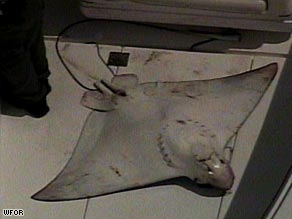
March 20, 2008
Here’s one for the “animal attack underestimation” file.
A stingray has killed a sunbathing woman in Florida, according to the Associated Press, on Thursday, March 20, 2008.

The unnamed woman died in the Florida Keys, near Marathon, after a stingray (the actual specimen, shown here) jumped out of the water and struck her upper body.
The spotted eagle ray (Aetobatus narinari) had hit the 55-year-old woman while she was in a boat.
Officials say she was hit in the face or neck. It’s not clear whether the animal’s barb struck the Michigan woman, or if the impact killed her.
Spotted eagle rays can grow up to 17 feet in length and weigh up to 500 pounds.
Steve Irwin was allegedly killed by what his crew said was a “bull ray.” The most commonly termed bull ray is Pteromylaeus bovinus, or the duckbill ray, a large stingray of the eagle ray (Myliobatidae) family found only along the coasts of Europe and Africa.
Irwin was killed on September 4, 2006, while filming a segment for a series entitled “Ocean’s Deadliest” at Batt reef off the coast of northeastern Queensland, Australia. No doubt Irwin was killed by an eagle ray (in the Myliobatidae family) called locally a “bull ray” in Australia.
Pondering this breaking story from the Keys today, I must puck the following quotation from the Washington Post for July 2, 2007:
Everybody always loves the big, toothy things, but there are more species of rays than sharks, and they are often overlooked,” said David A. Ebert, who studies rays and related species at the Pacific Shark Research Center at Moss Landing Marine Laboratories in California. “You look on television, it’s always ‘Shark Week.’ It’s never ‘Ray Week.'”
+++

Updated information indicates the woman was struck and died from her fall. (Thanks David Pescovitz.)
CBS4 from Florida is reporting the animal reportedly struck 57-year old Judy Kay Zagorski, from Pigeon, Michigan, who fell backward, suffered a severe head trauma, and died. Early reports that a barb had struck her in her neck were unfounded.
CBS4 overviewed more info on the species:
The Eagle Ray is common in the waters off South Florida and the Keys.
“It’s a common behavior for Eagles Rays to go ‘aerial’, or breach the surface,” said Robert Rose, a curator with the Miami Seaquarium. “There are many reasons why they do it. They could be fleeing a predator or trying to dislodge a parasite.”
Eagle Rays also jump when they are giving birth.
In South Florida waters, Rose said spotted Eagle Rays can grow up to 12 to 15 feet, from nose to tail, with a width or wingspan of 6 to 8 feet.
The tail, which has a venomous barb, has an interesting design,” said Rose, “it looks like it has multiple arrowheads.”
They pose no threat to humans in the wild.
Eagle Rays live close to the coast in depths of 3 to 60 feet and in exceptional cases they are found as deep as 900 feet.
The Eagle Ray is most commonly seen along sandy beaches in very shallow waters. The ray’s two wings sometimes break the surface and giving the impression of two sharks traveling together.
I would have to say that Ms. Judy Kay Zagorski would disagree with that “no threat to humans in the wild” comment.
About Loren Coleman
Loren Coleman is one of the world’s leading cryptozoologists, some say “the” leading living cryptozoologist. Certainly, he is acknowledged as the current living American researcher and writer who has most popularized cryptozoology in the late 20th and early 21st centuries.
Starting his fieldwork and investigations in 1960, after traveling and trekking extensively in pursuit of cryptozoological mysteries, Coleman began writing to share his experiences in 1969. An honorary member of Ivan T. Sanderson’s Society for the Investigation of the Unexplained in the 1970s, Coleman has been bestowed with similar honorary memberships of the North Idaho College Cryptozoology Club in 1983, and in subsequent years, that of the British Columbia Scientific Cryptozoology Club, CryptoSafari International, and other international organizations. He was also a Life Member and Benefactor of the International Society of Cryptozoology (now-defunct).
Loren Coleman’s daily blog, as a member of the Cryptomundo Team, served as an ongoing avenue of communication for the ever-growing body of cryptozoo news from 2005 through 2013. He returned as an infrequent contributor beginning Halloween week of 2015.
Coleman is the founder in 2003, and current director of the International Cryptozoology Museum in Portland, Maine.
Filed under Breaking News, Cryptotourism, CryptoZoo News, Cryptozoology, Obituaries, Out of Place